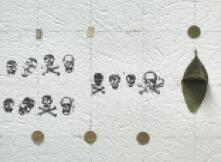Expansive References: Seven Ephemeral Murals
N-CE Arte, Bogota
The traditional concept of mural painting, that instrument which rendered art democratic, drawing the absent-minded viewer towards a certain world of ideas that endures in time as a soundly established document, is subverted by the exhibition of six contemporary artists intervening on the walls, and some- times the space of N-CE Arte with full awareness of the ephemeral nature of their messages.

In some cases, reflection arises from the discursive potential of the space, as in the case of Luz Ángela Lizarazo who, through her two large-scale opposing murals, which evoke the ornamental bars on doors and windows that protect houses and apartments in Colombian cities, proposes the encircling and at the same time the protection of the space where they have been installed; or in the work of Rodrigo Echeverri, who with a subtle drawing executed with red pigment on a raw cement wall invites the viewer to contemplate the space in silence, including all the possible “imperfections” of a place that is in permanent change and construction.
The works of Miguel Ángel Rojas and of Toxicómano reveal a social and political content; through a randomly built grid of coca leaves and drawn skulls mixed with beans, rice, coffee or lentils, the former creates a subtle atmosphere that masks the brutal real- ity experienced in Colombia as a result of the phenomenon of drug traffic; and the latter, with his already known mastery of graffiti, trivializes in his Historias de Independencia (Independence Stories) our already turbulent history − a turbulence that perhaps dates back to the days of our primitive Republic−, through the representation of a newspaper vendor as central element in his composition. In a more personal setting are the murals by Jaime Franco and Carlos Blanco. On the one hand Franco, through the execution of a monumental construction done in clay, which he calls Panóptico, densifies the characteristics of what at first sight is an apparently light structure, but which is evidently rendered heavy through the presence of the most earthly material (clay). Blanco, on the other hand, installs Post-it and several electric fans as part of a mural in which four colors form a large screen in shapes that can be “phallic or pertaining to weapons”, according to the exhibition curator, Guillermo Ovalle, and which denote an ambiguity characteristic of our current virtual and ephemeral world.





